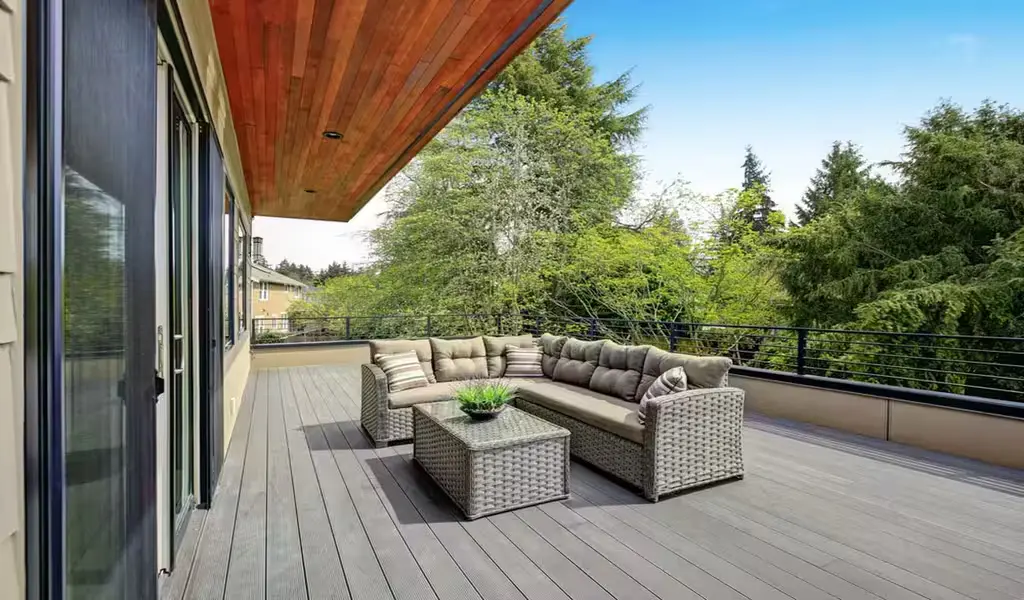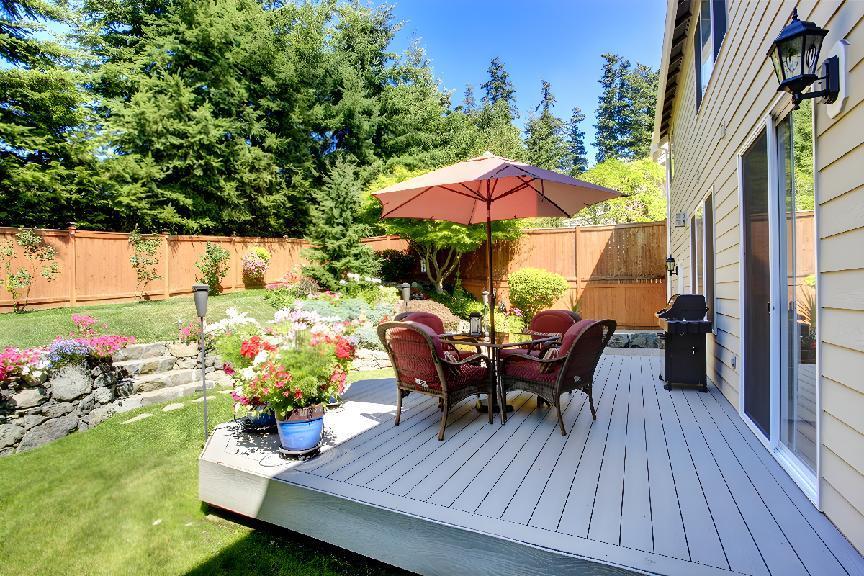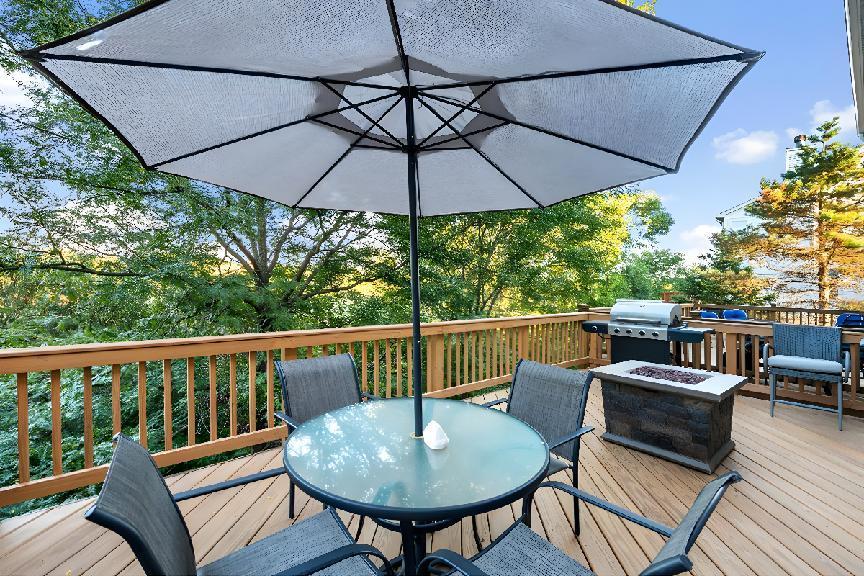Learning
The Cost of Installing a Modern Composite Deck

Outdoor decks have an indisputable place as an extension of your home life. Before constructing your outdoor flooring, everyone is concerned about the modern composite deck cost of the outdoor.
The typical deck cost for a homeowner is $2,200 for a 10×10 foot outdoor deck. A 14×20 foot deck costs $6,200 to build. A deck 20×20 feet long costs $8,800.
An outdoor deck costs roughly $22 per square foot to build. However, the cost of the deck is determined by the materials used, the size, and the level of construction. Additionally, there are choices such as built-in chairs or steps.

The average cost of a deck per square foot
The cost of constructing a deck is $22 per square foot. The average homeowner spends between $4,200 and $10,000. Decks constructed with low-priced materials cost $13 per square foot. Decks constructed with high-quality materials cost $32 per square foot.
In other words, deck materials have a significant impact on deck construction costs. The deck builder must select the best deck material for your situation. Furthermore, the cost of labor to manufacture the deck will influence the cost of the deck. Labor costs range from $8 and $20 per square foot, depending on the size of the outdoor deck, the materials used, the level of construction, the surrounding surroundings, and so on. Deck Construction Materials Costs
Pressure-treated timber, hardwood, and composite decking materials are the three most prevalent materials used to build outdoor decks in the United States. The statistics provided in the article are averages, and the specific price per square foot may vary based on where your outdoor living space is located.

Wood that has been pressure-treated
The cost of pressure-treated wood decking is $6 per square foot. It’s also the most popular and least expensive alternative. It meets people’s essential needs while being resistant to mold, insects, and rot.
Advantages and disadvantages of pressure-treated lumber
It is often constructed of low-grade fir or pine. Which is prone to warping and cracking over time and hence necessitates a careful maintenance schedule.
It is less water-resistant, therefore metal fittings are utilized to construct the deck when exposed to damp or water. Galvanized nails and screws, fasteners, joists, and other metals can corrode. If repairs are conducted on a regular basis to ensure the deck’s structural soundness.
If you choose to create your outdoor deck with these deck boards, you must maintain it on a regular basis, which includes sanding, sealing, and staining.
Wood Deck Prices
The supplies to build a deck using natural wood cost between $3 and $15 per square foot. Wood decks are attractive and popular, but they require extra upkeep, such as staining and sealing on a regular basis. The following are the most prevalent trim woods.
Cost of Cedar Wood
The material cost of cedar decking ranges from $4 to $8 per square foot, depending on the grade. Cedar is a naturally resistant softwood to weathering, insects, and rot. It does, however, require routine care like as sanding, sealing, and staining.
Advantages
Cedar is one of the less expensive materials used in deck construction.
Weathering, rotting, and wood-destroying insects such as termites are naturally resistant.
Cedar is simple to stain and seal, and it does not distort over time.
Disadvantages
Cedar decking is less durable than other hardwoods and more prone to scratches and dents.
Sanding, staining, and sealing are required on an annual basis.
Redwood Decking Prices
The most popular wood used in deck construction is redwood decking, which costs $7 per square foot. Again, constant maintenance is required to keep it running properly.
Advantages
Redwood is half the price of composite lumber.
Mahogany is ideal for staining or painting.
Mahogany is naturally pest and fire-resistant.
Redwood is strong and not readily bent.
Disadvantages
If a mahogany deck is not stained and sealed on a regular basis for upkeep. It can grow moldy and sun-damaged.
Composite Decking Price
Composite decking material costs between $10 and $15 per square foot. Which is typically slightly greater than the cost of wood flooring. Composite decking looks like real wood, has a surface that mimics natural wood grain, and can fulfill the demands of most individuals. The composite decking is produced from a combination of recycled plastic and wood fibers. Its use can also assist in decreasing plastic waste and protecting the environment.
Advantages of Composite Deck
Composite decks require extremely little upkeep.
Composite decking does not split or decay.
There are no chemicals in this product that can corrode metal fasteners.
Composite decking comes in a number of hues.
Composite materials do not require staining or sealing.
Some composites have the ability to be utilized as “hollow” planks, allowing wires or audio cables to pass through the core.
Disadvantages of Composite Deck
Because the product cannot be sanded, it does not restore its former sheen as easily as a wood deck.
The cost is slightly more than that of pressure-treated lumber.
The cost of constructing a deck staircase
If you need to install deck stairs, determine the cost of deck stairs based on the number of steps needed. A rough estimate of the cost of deck stairs is $40 per step. A few steps from the yard to the deck will create a pleasant transition. Depending on the size of your yard, one set may be enough, but you may want to add stairs on either side of the deck.
The pricing difference is determined by whether you want an open vertical space between each step or a closed space with matching risers. In addition, each set of steps utilized for support costs $50 in concrete.
Deck Railing Installation Cost
Depending on the materials used to build the deck, the typical deck cost to install deck railings is $20 per linear foot. Typically, the railing will not be on all four sides of the deck because one side will be parallel to the house.
Maintenance costs
Annual maintenance and repairs are essential when it comes to natural wood decking. With proper care, your wood deck can last 25 to 40 years before needing to be replaced. If your deck is not properly maintained, its lifespan can be shortened to 10 to 15 years.
Deck Staining Cost
Above all, the expense to sand, stain, and seal an outdoor deck ranges between $1 and $3 per square foot. If you simply need to fix a tiny area, you can buy a sealer and stain and finish the job yourself.
Stains – Available in opaque or semi-opaque acrylic latex, oil, or latex stains. For $30-$45 per gallon, you may cover up to 400 square feet of wood surface.
Clear or weatherproof wood treatments are available. It covers up to 400 square feet of wood surface and costs between $16 and $80 a gallon.
Deck sealing costs
Above all, a common wood sealer costs around $20 per gallon and is simple to apply yourself.
Wood Water Sealer – $16-$18 per gallon, covers 225 to 325 square feet of sanded lumber with an initial coat of 125 square feet of rough sawn lumber.
Wood Preservative – $24-$29 per gallon, covers 100 to 300 square feet.
SEE ALSO: 8 Reasons Why SEO is Essential for Thailand’s Tourism Industry

Learning
First-Time Buyer’s Guide to the UK Property Market

Entering the UK property market as a first-time buyer can feel both exciting and daunting. The process is filled with potential pitfalls and complex decisions, but with the right guidance, it can be navigated smoothly. The estate agents in Yorkshire demystify the journey from the initial decision to buy a home to the moment you step over the threshold of your new property.
Understanding Your Financial Position
The first and perhaps most crucial step in the home-buying process is understanding your financial situation. This includes assessing your savings, income, and current debts. Here’s how you can prepare:
1. Deposit: Generally, you’ll need at least 5% of the property price as a deposit, though aiming for 10% or more can provide better mortgage rates.
2. Income and Expenses: Use a budget planner to assess your monthly income against your expenses. This will help you understand how much you can afford in monthly mortgage repayments.
3. Credit Score: Lenders will evaluate your credit score to determine your mortgage eligibility. So it’s important to have a good credit score, and you should work on it if required.
4. Mortgage Options: Speak to a mortgage advisor to understand different types of mortgages, such as fixed-rate, variable-rate, and help-to-buy schemes.
Getting a Mortgage Agreement in Principle
A Mortgage Agreement in Principle (AIP) is a statement from a lender indicating how much they’ll likely lend you. You will be a more attractive buyer with an AIP as it shows sellers you’re serious and financially prepared.
Deciding What You Want
Before you start viewing properties, it’s essential to know what you’re looking for. Consider the following factors:
1. Location: Proximity to work, schools, public transport, and amenities are key. Research neighbourhoods to find the best fit for your lifestyle.
2. Property Type: Decide whether you want a flat, terraced house, semi-detached, or detached property. Each has its pros and cons.
3. Must-Haves: Make a list of non-negotiables, such as the number of bedrooms, garden size, and parking facilities.
4. Future Proofing: Consider your future needs. Are you planning to start a family? Do you need space for a home office?
Starting the Property Search
With a clear idea of what you’re looking for, you can begin your property search. Here are some tips:
1. Use Online Portals: Websites like Rightmove, Zoopla, and OnTheMarket are excellent starting points. Set up alerts to get notified of new listings that meet your criteria.
2. Visit Estate Agents: Register with local estate agents who can provide insights into the market and inform you of new properties before they’re listed online.
3. Attend Viewings: Don’t rush this part. Visit several properties to get a feel for what’s available in your price range.
Making an Offer
Once you find a property you love, it’s time to make an offer. Here’s how to approach it:
1. Research: Check the selling prices of similar properties in the area to gauge a fair offer.
2. Negotiate: Don’t be afraid to negotiate. The starting point is most usually the asking price.
3. Conditions: You might include conditions in your offer, such as the inclusion of certain fixtures or a specific moving date.
The Legal Process
If your offer is accepted, the legal process begins. You’ll need a solicitor or licensed conveyancer to handle the legalities. Here’s what to expect:
1. Conveyancing: This is the legal transfer of property ownership. Your solicitor will handle this, including conducting searches, dealing with the Land Registry, and transferring the funds.
2. Surveys and Inspections: Arrange for a property survey to check for structural issues. There are different types of surveys, from basic condition reports to full structural surveys.
3. Mortgage Finalisation: Once the survey is complete and satisfactory, your mortgage can be finalised.
4. Exchange of Contracts: This is when the sale becomes legally binding. You’ll pay your deposit at this stage.
5. Completion: On the agreed completion date, the remaining money is transferred, and you receive the keys to your new home.
Moving In
Moving day can be hectic, but planning can ease the stress:
1. Hire a Removal Company: Book a reliable removal company well in advance. Discover the best deals by getting quotes from multiple companies.
2. Pack Strategically: Label your boxes by room and keep essential items accessible.
3. Notify Utilities and Change Address: Inform your utility providers of your move date and update your address with banks, the DVLA, and other important institutions.
Settling In
Get settled. Introduce yourself to the neighbours, familiarise yourself with the local area, and really start to make the place your own.
Here are a few final tips:
1. Safety Checks: Make sure that your smoke alarms and carbon monoxide detectors are working, and make sure that you know where the gas and electricity meters are located.
2. Maintenance Plan: Keep a record of the smooth functioning of your new home with a maintenance schedule, complete with regular checks and seasonal tasks.
3. Personal Touches: Add personal touches to make the space feel like home. This can be from putting up family photos or redoing the decoration in your rooms.
Conclusion
Buying your very first home in the UK is most definitely a milestone, difficult and full of challenges but rewarding in the end. Such a philosophy guides you in understanding finances and knowing what you want to achieve from detailed research, and seeking professional advice that confidently helps you navigate the property market. Yes, the journey may have its hurdles, but in the end—owning your own home—the reward will be worth the effort. Welcome to your new chapter!
SEE ALSO: Conquer the Chaos: Hacks to Clean Your Home in Half the Time
Learning
5 Health Benefits of Regular Pedicures

There’s nothing quite like a pedicure to keep your feet looking and feeling their best, but did you know that pedicures do more than simply enhance the appearance of your feet? Many people don’t realize that regular pedicures can come with a wide range of health benefits that can promote the well-being of your feet, so here are some ways that your routine pedicure keeps both your toenails and feet in the best condition possible!
Smoother Skin
One of the biggest misconceptions about pedicures is that they only cater to and look after your toenails. While you’ll definitely be leaving each session with a fresh coat of nail polish, your pedicure can also do wonders for the health of your skin. Aside from trimming and shaping your nails and cuticles, you’ll notice that your nail technician also dedicates a few steps to the skin of your feet.
After inspecting your feet and looking for any issues or imperfections that may need to be addressed, your technician will work on an exfoliating scrub to remove any dead skin cells. This step may also be aided by a foot file, which can be used to buff away any calluses and other problem areas manually.
Softer Skin
After your nail technician addresses all the problem areas of your feet and removes any unwanted dead skin cells, he or she will often massage in a moisturizing product, such as lotion, cream, or butter, to ensure that your skin is properly moisturized. These products contain skin-loving ingredients that will ensure that your feet have everything they need to look and feel their best so that you can walk out of your pedicure with a renewed sense of confidence.
Healthier Nails
After your pedicure session, your nails will not only look better due to the fresh coat of nail polish, but they’ll also be healthier and stronger. This is because your nail technician takes their time to ensure that your nails are properly looked after through steps that include deep cleaning, nail trimming, nail filing, and cuticle care. All of these things work together to prevent issues like ingrown nails from occurring, all the while improving the appearance of your nails.
Increased Blood Circulation
While the specific steps included in your pedicure will depend on the beauty salon, most pedicures will have a massage step somewhere in the mix. One of the often overlooked benefits of these massages is the increased blood circulation, which can deliver more nutrients and oxygen to your feet and nails, promoting their health and appearance. Aside from that, better blood flow means reduced tension and soreness, as well as better distributed heat throughout your body.
Reduced Infections
A significant amount of dirt and bacteria can build up on your feet without you even realizing it, but pedicures can be a great way to prevent these from happening in the first place. The exfoliation step of a pedicure removes dead skin cells as well as all the debris that may have accumulated underneath, and the deep cleaning of your toenails and cuticles also gets rid of any impurities that may have slipped beneath them, which can stop infections from happening.
These are some of the many health benefits that you can look forward to at your next pedicure appointment. However, it’s worth noting that you need to book regular sessions to truly reap all the rewards. This can be difficult, especially when you don’t feel like driving to your nearest nail salon after a long day, but the good news is that you can enjoy the salon experience in the comfort of your own home with a home pedicure service.
Learning
Commercial Boiler Installation Services London

For businesses in the bustling city of London, having a reliable heating system is crucial. Whether you’re opening a new office, expanding your current premises, or simply upgrading an outdated system, commercial boiler installation services for businesses in London are essential to ensure your operations run smoothly and efficiently. Proper installation and maintenance of commercial boilers can make a significant difference in energy efficiency, cost savings, and the overall comfort of your workspace.
The Importance of Professional Installation
When it comes to installing a commercial boiler, professional expertise is paramount. Here’s why:
- Efficiency and Performance: Professional installation ensures that your boiler operates at peak efficiency, reducing energy consumption and lowering utility bills. A well-installed boiler can effectively meet the heating demands of your business without unnecessary energy waste.
- Safety: Commercial boilers are complex systems that require precise installation to operate safely. Professional installers adhere to stringent safety standards and regulations, minimizing the risk of accidents and ensuring the safety of your employees and premises.
- Compliance with Regulations: Commercial properties are subject to various building codes and regulations. Professional installers are well-versed in these requirements and ensure that your boiler system complies with all local laws and standards.
- Longevity and Reliability: Proper installation is critical to the longevity and reliability of your boiler. A professional installation can prevent common issues such as leaks, pressure problems, and system failures, ensuring that your boiler runs smoothly for years to come.
Key Considerations for Commercial Boiler Installation
When planning for a commercial boiler installation, several factors need to be considered:
- Type of Boiler: The type of boiler you choose will depend on your business’s specific needs. Options include gas boilers, oil boilers, and electric boilers, each with its own set of advantages. Consulting with a professional can help you determine the best choice for your business.
- Sizing and Capacity: The boiler’s size and capacity must match the heating demands of your commercial space. An undersized boiler will struggle to meet your needs, while an oversized one will lead to inefficiencies and higher costs.
- Location: The placement of your boiler affects its efficiency and accessibility for maintenance. Professional installers can help you choose the optimal location for your boiler.
- Integration with Existing Systems: If you’re upgrading or replacing an existing boiler, it’s essential to ensure compatibility with your current heating system. Professional installers can seamlessly integrate the new boiler with your existing setup.
Choosing the Right Installation Service

Selecting the right installation service provider is crucial to the success of your boiler installation project. Consider the following when making your choice:
- Experience and Expertise: Look for a provider with a proven track record in commercial boiler installations. Experienced installers can handle the complexities of commercial systems and provide high-quality workmanship.
- Reputation: Check reviews and testimonials from previous clients to gauge the provider’s reliability and customer satisfaction.
- Comprehensive Services: Choose a provider that offers a full range of services, including installation, maintenance, and repair. This ensures that all your boiler needs are met by a single, trusted source.
In London, ROWLEN is a reputable name known for delivering top-notch commercial boiler installation services. Their team of experts is dedicated to providing efficient, safe, and compliant installations tailored to the unique needs of businesses.
Conclusion
Investing in professional commercial boiler installation services for businesses in London is essential for ensuring efficiency, safety, and long-term reliability. By choosing an experienced and reputable service provider like ROWLEN, you can rest assured that your heating system will be installed correctly and maintained to the highest standards. Proper installation not only enhances the performance of your boiler but also contributes to the overall comfort and productivity of your business environment.
SEE ALSO:
-

 News4 years ago
News4 years agoLet’s Know About Ultra High Net Worth Individual
-
Entertainment2 years ago
Mabelle Prior: The Voice of Hope, Resilience, and Diversity Inspiring Generations
-
News11 years ago
Enviromental Groups Tell Mekong Leaders Lao Dam Evaluation Process Flawed
-

 Health4 years ago
Health4 years agoHow Much Ivermectin Should You Take?
-

 Tech3 years ago
Tech3 years agoTop Forex Brokers of 2023: Reviews and Analysis for Successful Trading
-

 Lifestyles3 years ago
Lifestyles3 years agoAries Soulmate Signs
-

 Entertainment3 years ago
Entertainment3 years agoWhat Should I Do If Disney Plus Keeps Logging Me Out of TV?
-

 Health3 years ago
Health3 years agoCan I Buy Ivermectin Without A Prescription in the USA?